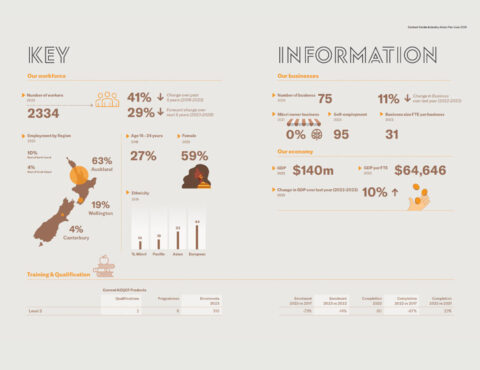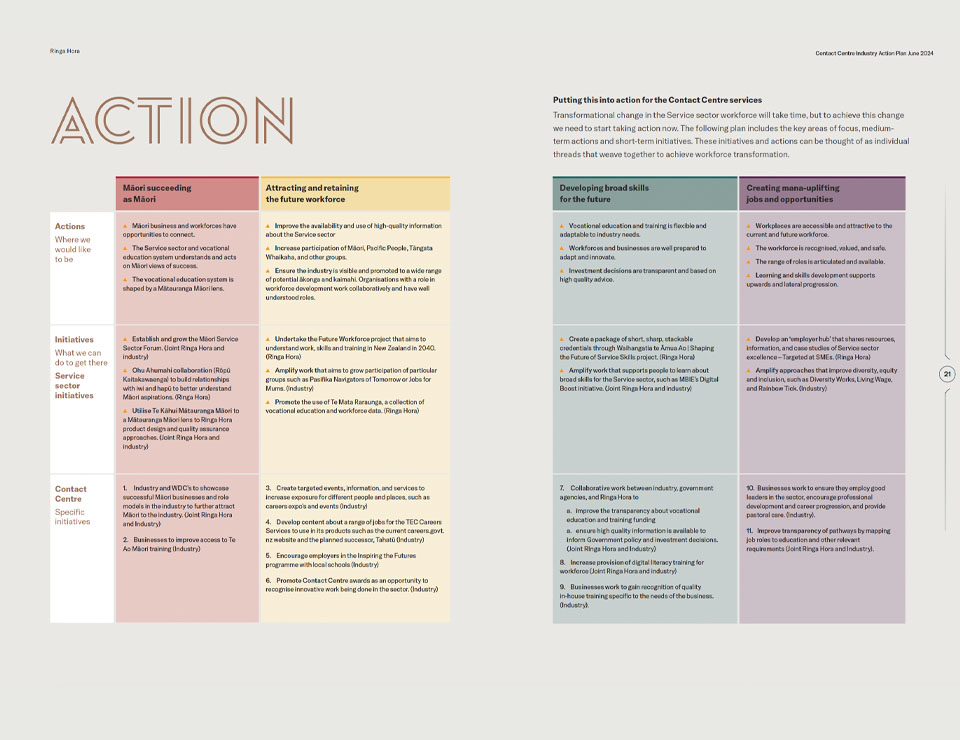
This year, our visual theme for each of the Industry Action Plans has been developed with a Te Ao Māori context in mind.
For the Contact Centre industry we lean into the symbolism of the Korimako, representing clear and effective communication, which is crucial in contact centres.

New Zealand’s contact centre industry will be a global leader, recognised for its thriving and dynamic workforce. The industry will not only excel in customer service but will also be a centre of career development, providing every worker with ample opportunities to progress within their careers, gain transferable skills, and grow into leadership roles.
The industry will embrace and lead the adoption of cutting-edge technologies, utilising AI, data analytics, and automation to enhance efficiency and empower the workforce. These technologies will be seamlessly integrated to support teams, allowing them to focus on what they do best—building strong, human connections with customers.
Contact centres play a crucial role in New Zealand’s business landscape, providing essential customer service support to businesses, government agencies, and banking institutions. These services have become increasingly vital due to several factors, including the growing number of businesses transitioning online and the rising complexity of customer inquiries, a trend further exacerbated by the digital age and the impact of COVID-19.

There are approximately 2,300 people employed in Contact Centres. This is down from 3,100 in previous years. Whilst there is an increase in demand for Contact Centre services, this decline in the Contact Centre workforce is reflective of more vendors using overseas contact centre staff and the uptick in technology adoption and subsequent efficiency.
The Contact Centre industry is considered an ‘accessible’ entry point for many entering the workforce, as it employs a high proportion of workers without tertiary education and has a range of flexible hours that might suit people who are studying or have other commitments outside of work.
However, the industry also provides a number of career pathways for many both in the sector as contact centre managers and outside of the industry through using their transferable skills, such as their customer service skills, problem solving and ability to rapidly adopt technology. This is particularly true as businesses continue to digitise their operations, interactions with customers become more complex, and contact centres face the challenge of addressing increasingly sophisticated enquiries. Whether it’s troubleshooting technical issues with online platforms, navigating intricate product specifications, or resolving disputes, contact centre workers possess the expertise and resources to provide effective solutions.
In addition, a number of industries use contact centres as recruitment and training grounds, such as finance and banks recruiting workers from their relevant contact centres.
There are two NZQF qualifications covering Contact Centres: New Zealand Certificate in Contact Centres (Level 3) and New Zealand Certificate in Contact Centres (Level 4), which is expiring in December 2024. There has been an increase in enrolments in these qualifications since 2021. In addition, contact centres tend to have a lot of in-house and on-job training which specialises to specific roles and offers learning opportunities to kaimahi between the Level 3 and Level 4 qualifications.
The industry association, providers, and Government, are actively collaborating to support training in the industry. For example, the Ministry of Social Development (MSD) and the Contact Centre Network New Zealand (CCNNZ) have formed a strategic partnership with industry providers to deliver a certified online course. This initiative is designed to equip kaimahi | workers with the skills needed for employment in the contact centre and related industries. Beyond preparing job seekers, the programme addresses the supply-demand dynamic by ensuring a steady flow of work-ready candidates for employers. It also emphasises the importance of pastoral care in the workplace, achieved through partnerships with providers, reflecting MSD’s commitment to holistic support for workers.


Explore Contact Centre industry workforce demographic, business, and economy statistics, and education and training data.
To help us reach the future state, we need to understand and tackle the challenges that the Contact Centres industry faces, while also seizing the opportunities that already exist or are on the horizon. These challenges are not new, as we have seen these continuing trends over recent years.






There are a number of considerations for industry to consider when adopting new technology such as Artificial Intelligence (AI) and developing analytics. These tools will undoubtedly impact the roles and responsibilities of the contact centre workforce and how they deliver and enhance the customer experience. Industry will continue to leverage technology to meet evolving customer demands while ensuring operational efficiency and security in contact centre operations.
This aligns with some key digital transformation trends of 2024 identified by Customer Contact Network New Zealand (CCNNZ) in recent research:
Increasing efficiency for workers and customers
The potential uses and applications of AI and analytics are expanding. They can be utilised for more than just process automation; they can also be used to support the analysis of customer interactions, behaviours, and trends to assess how businesses can improve the overall customer service experience. AI and analytics can also be used to direct and triage calls efficiently based on various criteria, and actually understanding abstract context and sentiment, thereby reducing wait times and improving resolution rates.
Improving customer experience
Contact centres need to use AI and analytics to support the customer experience and avoid employing robotic voice and basic chatbots, which would alienate customers. Instead, industry can use these digital tools to deliver personalised and empathetic responses. This personalisation of offerings including tailored service approaches, could promote customer loyalty and retention.
Promoting accessibility for customers and workers
Deep learning and generative AI are supporting customers to access contact centre services in many different ways, including reducing barriers such as language or accent as AI can easily understand and deliver the required answers. This will reduce frustration, promote accessibility of services, and support the customer experience.
Creating training opportunities for workers
There is an increase in the number of hybrid contact centres, blending on-site and remote operations. This has workforce training implications, as contact centres are increasingly requiring workers to respond through different multimedia channels simultaneously and upskilling on technology usage may be required. In addition, analytics and AI can be used to assess employee performance and identify training opportunities for workers based on recorded intgeractions, and assist workers to adapt to changing behaviours and requirements.
Increasing revenue for industry
The financial advantages of automation are clear, with processes in HR and finance becoming more streamlined and freeing up kaimahi to focus more on customer needs and the quality of the experience.

Productivity in business means being able to do more with fewer people. Businesses with high productivity are more resilient, able to adapt to changes more easily and promote growth and innovation. High business productivity per capita means an improved wellbeing by increasing the nation’s income and our ability to produce and afford the goods and services that underpin a happy, healthy life.
Digital Uptake in Contact Centres will support industry productivity
Technology investment is key to contact centres improving efficiency and lifting productivity in the industry (as discussed in the Application of AI and technology in contact centres section of the action plan). The 2023 Customer Contact Network New Zealand (CCNNZ) Industry Research Report identified the three most common technology investments by industry:
These investments will support industry to identify customer trends, automate processes where possible and overall create a more efficient and improved the customer experience. This evident as reports show that investment on conversational AI solutions within contact centres worldwide reached $1.99 billion in 2022 and is predicted to reduce costs by $80 billion by 2026.

This has implications for the Service sector, and more specifically, for the Contact Centre industry. It will change who services are delivered for and by, even the range of language options they offer. Noting that there are already a high proportion of Māori and Pacific people working in the contact centre industry, it will become more important for industry to reflect its workforce and customers, and for that workforce to be more culturally aware. This will support contact centres in remaining local and maintaining customer relationships in a culturally rich, and diverse market. There is proven economic and social benefit for employers, the workforce, and the wider communities.
Industry will be able to attract and recruit more people into the workforce, ensure that those workers feel safe and valued in their roles, and help them to promote the customer experience and loyalty.
Each of these groups makes a unique contribution to the Service sector, and businesses will benefit from recognising this contribution and being responsive to their individual needs.

There is a high proportion of Māori in the Contact Centre industry, at approximately 14% of the contact centre workforce.
Māori business ownership
There are a number of Māori-owned businesses in the industry (11%) which often focus on supporting Māori in the sector. A deep purpose and long-term horizons are crucial for Māori business. From this foundation, financial sustainability will come, and in turn, Māori will provide employment opportunities for rangatahi and whānau, to find creative ways to keep people employed in times of adversity and to showcase their culture and express themselves to others through their product. Therefore, it is important for businesses to understand the funding and supports available to them to enable them to thrive and grow.
Leadership and management
There is a high proportion of Māori in the contact centre workforce. This is likely because many Māori can see themselves reflected in the industry. There are clear pathways for many Māori into specific industries and into management and leadership roles. Many industries use contact centres as a training ground pathway into other roles in finance and banks, and into leadership positions and management roles.
Cultural competency
Increasingly workplaces are taking steps to ensure they are welcoming and reflective of this unique Aotearoa context, for example by supporting Te Ao Māori training, emphasising the alignment of cultural values. Additionally increasing Te Ao Māori practices across the board will build a better workplace environment for employees, where their values are acknowledged and identified as a strength. This will promote an industry with a robust Māori workforce that bring a wide skiillset associated with Te Ao Māori with them.

There is a high proportion of Pacific peoples in the Contact Centre industry, at approximately 19% of the contact centre workforce.
Career pathways
Contact centres have a high proportion of Pacific workers, compared to both the Service sector more broadly and the New Zealand workforce. The industry provides clear pathways to leadership and managerial roles which provides opportunities for Pacific people in terms of career progression and skill development.
Accessibility of training
The industry has a high proportion of Pacific workers, some of whom are second-language English speakers. However, this is not taken into account for training material and qualification requirements, particularly for literacy and numeracy, as these are often written in a way that does not resonate with Pacific workers. These requirements often mean that training and development opportunties are not always accessible and this can prevent Pacific workers from successfully pursuing higher level credentials and leadership roles. Therefore, it is important for industry to better understand the needs of their workers and also ensure that tailored training is offered to Pacific workers, along with pastoral care; both have been identified as critical to supporting and retaining kaimahi of Pacific descent.
Values-based work
The industry is well aligned with Pacific values, particularly its focus on assisting others, and working collaboratively as a team. Having a high proportion of Pacific people enables contact centres to better understand and reflect the needs of their increasingly diverse customers.
Cultural sensitivity and respect
Ensuring workplaces are inclusive of Pacific cultural practices and traditions, including appropriate observance of cultural holidays and ceremonies. Providing cultural competency training for employers and managers to better understand and support Pacific workers.
For Pacific communities, cultural competency extends beyond understanding cultural practices. It involves recognising and aligning with core values that uplift organisational capabilities. This approach fosters an environment where all employees feel valued, heard, and seen, promoting continuous improvement and inclusivity.

Transformational change in the Service sector workforce will take time, but to achieve that change, we need to start taking action now. This plan includes the key areas of focus, medium-term actions and short-term initiatives. These initiatives and actions can be thought of as individual threads that weave together to achieve workforce transformation.
To support progress with these actions, we have monitored what has been achieved in the last 12 months and what more will be delivered in future.
Download our actions and progress: